

0670-B3
J. Sayer, V. Kapos, S. Mansourian and Stewart Maginnis 1
In many deforested, degraded and fragmented forest habitats investments in restoration and rehabilitation can yield high conservation benefits. Restoration in densely settled tropical areas can have more impact on biodiversity than further extension of "paper parks" in remote, pristine forests and can also deliver important forest goods and services to a wider range of stakeholders. Retention of even small fragments of natural vegetation is justified by their great potential value in providing the building blocks for future restoration programmes. However, care needs to be taken in planning and executing such programmes. Spatial modelling tools can be used to formulate scenarios for optimal multifunctional landscapes and indicate where restoration investments will have maximum pay-off. The use of these tools needs to be supported by a high degree of participation from, and negotiation among, the full range of stakeholders, to identify the most important goods and services that need to be delivered by a particular landscape. Spatial analysis tools can also be used to provide a framework for negotiation. The objectives of all stakeholders, including conservation organizations, should be clearly articulated in ways that are amenable to effective monitoring and evaluation.
The prevailing paradigm of conservation organisations is to strive to conserve as much natural habitat as possible. However, forest conservation costs money, both in terms of direct costs (staff, purchase of vehicles and other costs associated with managing protected areas), and in terms of the opportunity costs associated with the land allocated for conservation. Both the management costs of conservation areas and the opportunity costs are a function of the relative profitability of alternative land uses. It is more costly to establish and maintain a protected area in a locality where profits from farming or logging would have to be foregone or where significant development has already increased the value of land (Balmford et al. in review). It is therefore easier to locate protected areas in places where competition for land is minimised. As a result, much of the global effort to conserve forests, especially in the developing tropical world, has to date focussed on the establishment of parks and protected areas in remote areas where forests are still well-preserved and the lack of conflicting demands on the land helps keep costs down. Much of the conservation forest estate is therefore composed of the "residual forests" on land that has not, up until now, been required for any other purpose (Pressey and Olson in press).
However, there are a number of reasons why this approach may be inadequate to meet forest conservation needs in the longer term. Firstly, the demands on land in areas that are remote at present are likely to increase as development facilitates access and economic activity in even the most remote areas (UNEP 2002). The resources and effort devoted to the management of currently remote protected areas will need to be enhanced as the development frontier advances. Secondly, precisely because of their remoteness, such protected areas cannot meet the needs of society, and especially the poor, for forest goods and services. Provision of timber and non-timber products, storage of carbon and protection of soils and river catchments are all needed in areas that are settled and in many cases degraded. Priorities for biodiversity conservation, as determined by the occurrence of species and ecosystems of national or international concern, often include areas where ecosystems are already significantly degraded (Brooks et al. 2002).
The needs for securing or enhancing the supply of forest goods and services including biodiversity are often most urgent in areas where forest ecosystems may already have been severely disrupted or degraded. In response to this situation several countries are embarking on major investments in reforestation, but often these programmes are driven by a very narrow vision of the values of forests. They are not based on a sound understanding of the full spectrum of forest values that are required by diverse local stakeholders, and may ignore underlying social and environmental problems and potentials. The approaches often give too much emphasis to extensive planting of monocultures of exotic species and not enough to natural regeneration and the management of the fire, over-grazing and over-exploitation that are the causes of degradation.
Several initiatives now promote the careful planning and execution of forest restoration programmes with a view to enhancing the full range of benefits they can provide. The International Tropical Timber Organisation has recently developed a set of guidelines on the restoration of degraded Forests (ITTO, 2002). The Society for Ecological Restoration has completed both guidelines (Clewell et al. 2000) and a primer (SER 2002) that provide insight that is applicable to forest restoration. The WorldWide Fund for Nature (WWF) and the World Conservation Union (IUCN) are engaged in a major initiative to promote Forest Landscape Restoration (FLR). This is defined as a process of forest restoration that aims to regain ecological integrity and enhance human wellbeing in degraded forest landscapes. This approach requires that individual elements of a land-use mosaic should not be viewed in isolation. Thus, for example, gamma biological diversity (the sum of the diversity of the different elements of the larger landscape) becomes a more important criterion for evaluating biodiversity than alpha diversity (the diversity at the level of the management unit or single habitat patch). Maximising gamma diversity can be a more acceptable means for securing biological diversity whilst retaining options for making productive use of parts of the landscape (Lamb 2002). In general we believe that the options for ensuring sustained supplies of all forest goods and services should be evaluated for the landscape as a whole and not at the level of individual management units.
Forest landscape restoration deals with the integrated management of large forest systems. Its goal is to both regain ecological integrity and enhance human wellbeing. Achieving this objective requires equitable negotiations amongst all concerned stakeholders. Spatial data and their analysis can support negotiations and decision making by providing information on the status of the landscape and the likely impact of different restoration strategies. Spatial analysis can help practitioners to:
The following three approaches developed at UNEP-WCMC have significant potential as tools to support forest landscape restoration.
In the area of priority setting, analysis using geographic information systems (GIS) provides a useful means of integrating the many different types of information that need to be taken into account. This can be undertaken at any scale, from plot level, through landscape scale, to national and regional planning. However for FLR the focus is on intermediate sized landscapes whose size depends upon the extent of influence of the people and institutions concerned. In areas with dense infrastructure and high populations the landscape will be smaller than in remote forest areas with sparse populations. In general there are not rigid boundaries to the areas where we intervene. At any given scale, the analyses can only be as good as the available data, so that data availability is the major constraint on their implementation. Nonetheless, especially at broader landscape scales the use of spatially explicit data is a valuable resource for formulating scenarios and negotiating desirable outcomes.
Initial analyses can be useful at a very large scale. For instance an analysis for the entire Mediterranean Basin (Fig 1) shows how the progressive addition of layers of spatial data can help to refine the selection of landscapes and sites for restoration. The analysis starts with remotely sensed data on current forest cover and its comparison with the extent of potential forest cover (derived from climatic and historical data). This comparison provides an estimate of where forest cover has been lost and could potentially be restored. Then, indicators of conflicting demands on land are used to eliminate areas that are unlikely to be available for restoration. In the example, intensity of clearing (areas with no remaining woodland at all) or cropland and human population density are used, and other data can be incorporated, for example on legal designations of land, ownership, tenure rights or other factors affecting the availability of the land for restoration. Finally, additional indicators related to the biophysical feasibility of restoration are incorporated. In this example, proximity to existing forest was considered to increase the feasibility of establishing native species and the likelihood that restoration activities would generate effective increments in habitat for biodiversity. Other data that might be used at this stage of the analysis include soil condition, fire frequency, and environmental suitability for target species.
The resulting surface of restoration potential based on opportunity and feasibility can then be combined with measures of benefit, such as biodiversity preservation or other ecosystem services to identify areas where both feasibility and potential benefits from restoration are high. This analysis can highlight where maximum gains in biodiversity protection might be obtained from restoration. Similar results can be obtained on areas important for catchment protection, or areas needed to provide local communities with forest products.
The key part of this process is the selection of appropriate criteria, which should be part of the negotiations that involve stakeholders of all types. The outputs from analyses like this can inform stakeholder negotiations for FLR in important ways. Continued refinement of these approaches can be achieved through their application at finer scales and by comparing the results of such analyses with the locations and achievements of existing restoration projects.
The second major application of spatial analysis in support of forest landscape restoration is in analysing the vulnerabilities of existing forests and of candidate areas for restoration. In these analyses the limiting factor is often data availability. Spatial data on demand for wood products for example can be hard to come by, so that proxies such as road distribution are often used instead.
For example, analysis of a portion of the 10th region of southern Chile (Fig. 2; Wilson et al. 2002) used historical data on land cover and environmental variables to predict threats of conversion to forest plantations and agriculture, the most important risk factors for natural forests in this region. The resulting probabilities of conversion can then be further modified by data on specific factors contributing to pressure, such as distance from roads. Vulnerabilities derived in this way can be summed and combined to provide further refinement of landscape restoration strategies.
A third application of spatial analysis involves identifying where restoration can have the greatest impact in enhancing the ecological integrity of a landscape and monitoring progress towards that goal. Forest fragmentation is one of the most important factors reducing the integrity of forest habitats. It affects forest biodiversity through three principal mechanisms: area effects, edge or shape effects and isolation effects. The small size of forest fragments means that only a subset of the biodiversity of larger tracts of forest is present and retained within them. The edges of forest patches have environmental conditions that are strongly influenced by the surrounding land cover and may be adverse for forest interior species, and these edges are vulnerable to colonisation by invasive species. The isolation of fragments from other forest areas leads to reduced movement of species that are unable to cross non-forest land, reduced gene flow and increased probabilities of local extinctions. Using spatial analysis, the fragmentation of a forest landscape can be quantified from land cover data using metrics that address each of these types of ecological effects. These include patch size, spatially weighted forest frequency; and connectivity to core forest. An index of spatial integrity (Kapos et al. 2000) which is calculated by combining these metrics, provides a useful summary measure of the spatial integrity of forest cover in any given landscape that can be presented in both mapped and statistical form (Fig. 3). These provide baselines for monitoring progress. The analysis can also be adapted to identify where in a landscape the maximum gain in forest spatial integrity can be achieved for a given increment in forest area through restoration.
While the spatial analysis methods described above provide important tools for setting priorities and monitoring progress in forest landscape restoration, in their present form they are heavily dominated by biophysical considerations. The challenge now is to adapt these and other tools to take account of the full range of benefits that are required from any given landscape. An important element will be employing methods for determining local peoples' knowledge and interests and incorporating them into the thinking about land-use options from the beginning. Sheil and Wunder (2002) have discussed the difficulties of formal forest valuation techniques in capturing the real determinants of local decision making. There is abundant evidence from many field programmes that more sustainable outcomes are achieved if all stakeholders are involved early in, and throughout, the process of development of scenarios for forest conservation. It is also likely that local processes will identify more finely grained mosaics of land use and reveal a greater variety of management options than an externally generated conservation plan.
Many of the rules for securing effective participation are common to all local level natural resource management activities. For instance it is important that such negotiations are genuinely equitable and that power differentials are not allowed to prevail. It is necessary that the conservation lobby is explicit about its conservation objectives. Negotiations will be more meaningful if conservation objectives are spelled-out in terms of the species or species assemblages that need to be conserved and the resources that conservationists can contribute. Hagmann et al. (2002) provide valuable guidance on the conduct of such negotiation processes.
It is important to recognise that technical and participatory tools for planning and prioritising landscape management and restoration can be complementary in important ways. Spatial analysis and mapped data can help participants to visualise others' values of the landscape and the options available for its management. Effective participation can help to generate value surfaces other than those commonly available to the scientifically based conservation community. Analytical tools and approaches such as analyses of complementarity can be used to identify potential landscape management options that maximise improvements with respect to a number of different goods and services.
Another important use for complementary application of technical and participatory approaches is in monitoring the progress of restoration programmes in improving the ability of a landscape to deliver the forest goods and services that are important to its stakeholders.
Forest landscape restoration is an approach to forest conservation that can provide high pay-offs for a range of forest benefits. It recognises that complementarity can be fostered between the different components of landscape mosaics - that the whole can be more than the sum of the parts. The key characteristics of the approach are:
For most practitioners, there is much to learn about this and other approaches to forest restoration; expertise, information and experience are widely scattered. To facilitate the learning process, the Forest Restoration Service (FRIS: http://www.unep-wcmc.org/forest/restoration) provides access to key documents, concepts and case studies as well as details of ongoing restoration initiatives.
Balmford, A., K. Gaston, S. Blyth, A. James and V. Kapos. In review. Global variation in terrestrial conservation costs, conservation benefits, and unmet conservation needs. Proceedings of the National Academy of Sciences.
Brooks, T. M., R. A. Mittermeier, C. G. Mittermeier, G. A. B. da Fonseca, A. B. Rylands, W. R. Konstant, P. Flick, J. Pilgrim, S. Oldfield, G. Magin, and C. Hilton-Taylor. 2002. Habitat Loss and Extinction in the Hotspots of Biodiversity., Conservation Biology 16: 909-923.
Clewell, A., J. Rieger and J. Munro. 2000. Guidelines for Developing and Managing Ecological Restoration Projects. Society for Ecological Restoration. http://www.ser.org
Lamb, D. 2002. From Local to Landscape: How to Restore Degraded Landscapes as well as Degraded Lands. http://www.iucn.org/themes/fcp/activities/publications/flr_lamb_ext.doc
Hagmann, J., E. Chuma, K. Muriwira, M. Connolly, and P. Ficarelli. 2002. Success factors in integrated natural resource management R&D: lessons from practice. Conservation Ecology 5(2):29. [online] URL: http://www.consecol.org/vol5/iss2/art29
ITTO. 2002. ITTO Guidelines for the restoration, management and rehabilitation of degraded and secondary tropical forests. International Tropical Timber Organization, Yokohama, Japan.
Kapos, V., I. Lysenko and R. Lesslie. 2000. Assessing Forest Integrity and Naturalness in Relation to Biodiversity. 60 pp. UNEP-World Conservation Monitoring Centre, Cambridge, U.K
Pressey, R and D. Olson. In press. A framework for conservation planning.
SER 2002. The SER Primer on Ecological Restoration. Society for Ecological Restoration International Science & Policy Working Group. http://www.ser.org.
Sheil, D. and S. Wunder. 2002. The value of tropical forests for local communities: Complications, caveats and cautions. Conservation Ecology online URL: http://www.consecol.org/vol15/iss2/art9
Wilson, K. In prep. Incorporating Data Uncertainty And Vulnerability Into The Selection of Conservation Reserves. Ph.D. Dissertation. University of Queensland, Australia.
UNEP 2000. Global Environmental Outlook 3. United Nations Environment Program, Nairobi, Kenya.
Figure 1. Results of a regional-scale analysis to identify priority areas for forest restoration in the Mediterranean, starting from an overlay of potential and current forest cover that results in (1) an overview of which areas that were once forested no longer contain forest. This broad area of opportunity is progressively modified according to data on factors judged to increase the feasibility of restoration such as occurrence of woodland in the landcover mosaic (2), low human population density (3), and proximity to extant forest cover (4). A synthesis of these views (5) shows a sliding scale of combined potential or feasibility from these different layers, which can be combined with measures of potential benefit in terms of biodiversity conservation or other forest ecosystem goods and services.
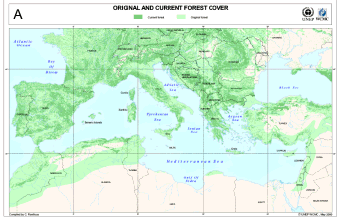
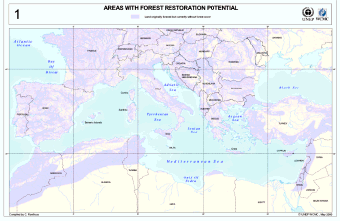



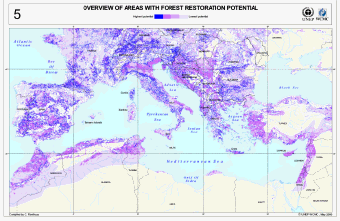
Figure 2. Prediction surface showing the probability of conversion from forest to forest plantation based on models derived from historical data (from Wilson in prep).

Figure 3a. The forest cover of Paraguay displayed according to classes of Forest Spatial Integrity Index. The index reflects the size shape and connectivity of each forest patch and can be used to forecast where a given increase in forest area would produce the greatest gain in ecological integrity.
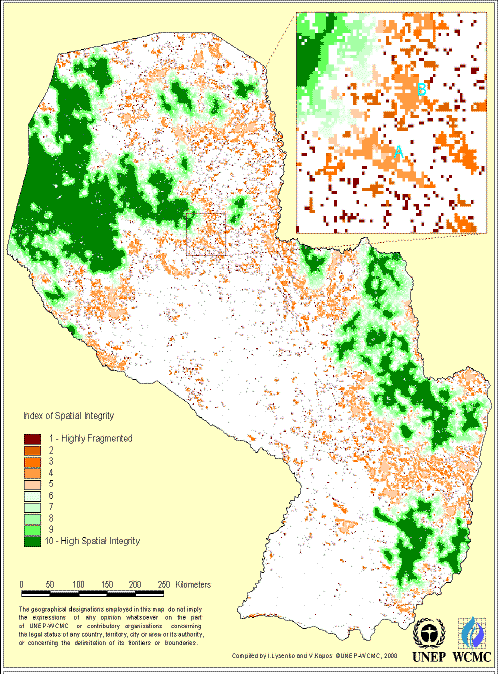
Figure 3b. Statistical summary of the forest area of Paraguay belonging to different classes of spatial integrity index, which combines information on patch size, shape and isolation. This kind of summary can be used as a baseline for monitoring changes in forest fragmentation that might result from restoration efforts
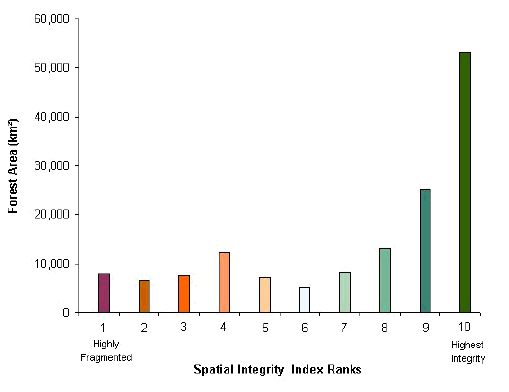
1 WWF International, Avenue du Mont Blanc, 1196 Gland, Switzerland. [email protected]